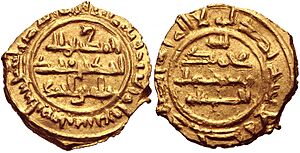Abu Ja'far Ahmad ibn Muhammad facts for kids
Quick facts for kids Ahmad ibn Muhammad |
|
|---|---|
| Amir of the Saffarid dynasty | |

Coin of Ahmad
|
|
| Reign | 923–963 |
| Predecessor | Amr ibn Ya'qub |
| Successor | Khalaf ibn Ahmad |
| Died | March 963 Zarang |
| House | Saffarids |
| Father | Muhammad ibn Khalaf |
| Religion | Sunni Islam |
Abu Ja'far Ahmad ibn Muhammad (born June 21, 906 – died March 31, 963) was a powerful ruler, known as an amir, of a region called Sistan. He ruled from 923 until his death in 963. He is famous for bringing back the Saffarid family's power in Sistan. Ahmad was also a big supporter of art and learning.
Contents
Becoming a Ruler: Ahmad's Rise to Power
Ahmad's journey to becoming a ruler started in May 923. The people of Zarang, the capital city, chose him as their new amir. At that time, Sistan was ruled by someone named 'Abdallah ibn Ahmad. Many people in Zarang did not like 'Abdallah because he made them pay very high taxes.
Ahmad had connections to the old Saffarid ruling family. Because of this, he gained the support of local groups called 'ayyars. These groups helped him stop 'Abdallah's son, 'Aziz, from keeping control of the city.
Soon, Ahmad's rule grew beyond Zarang. 'Abdallah's helper in al-Rukhkhaj switched sides and joined Ahmad. The people of Bust also decided to support Ahmad. 'Abdallah was defeated in battle by Ahmad's supporters. He tried to escape to Samanid Khurasan, but he was caught. In October 923, he was brought back to Zarang, and his rule ended for good.
Dealing with Rebellions
Even though 'Abdallah was no longer a threat, his son 'Aziz still opposed Ahmad. Some of Ahmad's own supporters turned against him and backed 'Aziz. This forced Ahmad to march to Bust twice to stop these rebels. 'Aziz tried to take over Sistan, but Ahmad's army defeated him in late 925. 'Aziz then ran away to Khurasan, ending his attempt to seize power.
After successfully defending his rule, Ahmad wanted to make his kingdom bigger. He looked to the Abbasid Caliphate, a large empire that was facing many problems. Ahmad sent his officials to Kerman, a province that used to belong to the Saffarids. These officials collected taxes and then returned to Sistan. However, the Saffarids' control over Kerman was only for a short time. The Abbasids held onto the province for a few more years before the Banu Ilyas family took over in 932.
Ahmad continued to face problems in Bust. In 931, he had to go there himself to deal with a rebellion. Another army was sent the next year. Events in the nearby Samanid kingdom also caused trouble. In 930, a plan to overthrow the Samanid ruler Nasr b. Ahmad failed. Some people involved in this plan arrived in Bust in 932. They had troops with them and attacked Ahmad's governor there. Ahmad had to lead his army to Bust and defeat these fugitives. Because he was often needed in Bust and other eastern areas, Ahmad often left Zarang in the care of three sons of a man named Tahir b. Asnam.
A Time of Peace and Learning
After these early challenges, Sistan and its surrounding areas became calm for several years. This made for a peaceful time during Ahmad's rule. Other rulers respected him. Even the Samanids, who were usually enemies of the Saffarids, seemed friendly with him. A famous poet named Rudaki even praised Ahmad at the Samanid court in Bukhara. Other poets, both Persian and Arabic, also admired Ahmad. Many important meetings for scholars took place in Sistan. Famous thinkers like Abu Sulayman Muhammad al-Sijistani and Nasafi attended these gatherings.
Later Years and Challenges
This peace did not last forever. Different groups outside the capital city began fighting each other. This forced Ahmad to send his army to deal with the unrest. From the 950s onwards, Sistan faced ongoing troubles.
Meanwhile, the three sons of Tahir b. Asnam, who sometimes governed Zarang when Ahmad was away, lost his favor and were put in prison. In their place, Abu’l-Fath, the army commander, took over many government duties. However, he eventually rebelled and gained a lot of support from people outside Zarang. Abu’l-Fath was also supported by another Saffarid, Abu’l-‘Abbas b. Tahir. Abu’l-‘Abbas claimed to be directly related to the first Saffarid rulers. Ahmad, on the other hand, was only related to the Saffarid family through his mother.
The rebel Abu’l-‘Abbas, along with Abu’l-Fath, marched towards Zarang. Ahmad met them in battle. With the help of Turkish soldiers from Bust, he defeated the rebels. Abu’l-Fath escaped to Nishapur, where he later died in the summer of 963.
Abu’l-‘Abbas, however, joined a plot with one of Ahmad's Turkish guards, called a ghulam. Together, they killed Ahmad during a gathering at the end of March 963. They also took his treasures. Ahmad's son and chosen heir, Abu Ahmad Khalaf, was outside the capital the night of the murder. Less than two months later, he managed to take control of Zarang.
Sources
- Bosworth, C.E. The History of the Saffarids of Sistan and the Maliks of Nimruz (247/861 to 949/1542-3). Costa Mesa, California: Mazda Publishers, 1994.
| Preceded by Abu Hafs 'Amr |
Saffarid amir 923–963 |
Succeeded by Abu Ahmad Khalaf |
| Preceded by 'Abdallah ibn Ahmad |
Amir of Sistan 923–963 |
Succeeded by Abu Ahmad Khalaf |

